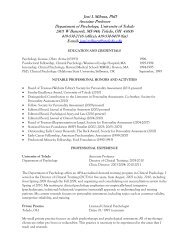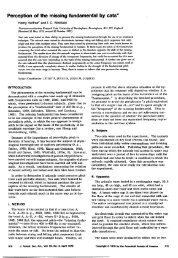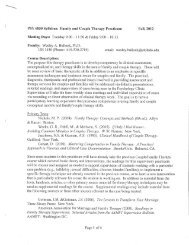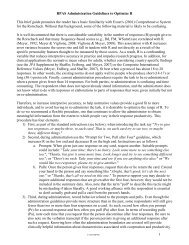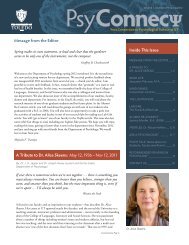The Rorschach Rating Scale: Item Adequacy, Scale ... - Psychology
The Rorschach Rating Scale: Item Adequacy, Scale ... - Psychology
The Rorschach Rating Scale: Item Adequacy, Scale ... - Psychology
- No tags were found...
You also want an ePaper? Increase the reach of your titles
YUMPU automatically turns print PDFs into web optimized ePapers that Google loves.
224 MEYER, BATES, GACONOally all relevant studies rely on the input of lay raters. Not only will it be valuable toreplicate our analyses using experienced clinicians who are clearly familiar with theforms of psychopathology embodied in RRS constructs, but it will be important toexplore the impact of rater sophistication on the factor structure of other clinical assessmentinstruments.Our results indicated that RRS items can be organized into 19 conceptual scalesor, based on our sample of raters, six broad factor scales. We developed these scaleswithout regard to underlying <strong>Rorschach</strong> scores. Consequently, they are not simplyderivedfromtheComprehensiveSystem(Exner,1993),butrathertheyemergefromallthescoringsystemsincludedintheRRS.Also,thedatapresentedhereindonotindicatethe factor structures that would be found with actual <strong>Rorschach</strong> scores. Instead,the data show how constructs thought to be associated with the <strong>Rorschach</strong> areorganized and interrelated in the minds of our raters. Many methodological differencesexist between an observer-rating scale such as the RRS and the <strong>Rorschach</strong> taskitself. Because method-specific variance has a pervasive impact on scores obtainedfrom any assessment device (Meyer, 1996b, 1997; Meyer et al., 1998), it is unlikelythatthefactorsobservedinthisstudywillhaveexactparallelsinananalysisofactual<strong>Rorschach</strong> scores (see Meyer, 1992, for a review of the latter).As indicated earlier, the item content of the RRS reflects a <strong>Rorschach</strong>-based“model” of personality because each item is tied to a score thought to capture animportant manifestation of personality and psychopathology. In terms of correspondencebetween B5M and RRS personality constructs, the factor solutions andregression analyses indicated they shared some areas of substantial overlap. However,the RRS and B5M items also contained distinct information. Despite our deliberateefforts, the RRS did not provide good markers for the I/O or E dimensionsof the B5M. Conversely, the B5M did not provide good marker variables for threeof the six RRS dimensions: (a) Perceptual Distortions and Thought Disorder; (b)Passive Dependence, Vulnerability, and Inferiority; and (c) Intellectual Defensesand Obsessive Character.When considering correspondence, one finding initially may seem paradoxical.RRS Factor 3 (Passive Dependence, Vulnerability, and Inferiority) was an excellentmarker for N when RRS scales were factored with B5M items (Table 3). However,the relation was not symmetrical. When the B5M scales were factored with all theRRS items, the B5M N scale had moderate loadings on three RRS dimensions (Factors1, 3, and 4). However, it was not a good marker for any of these, including PassiveDependence, Vulnerability, and Inferiority. Thus, even though RRS Factor 3 isa good marker for N, the reverse is not true because RRS items partition neuroticismvariance into more narrowly defined constructs. As a result, N does not allow for therefined measurement of these more focused characteristics.Given the preceding, future research could profitably examine whether modeloverlap is greater when the RRS is examined alongside more focused scales fromthe five-factor tradition. Currently, Costa and McCrae’s (1992b) NEO–PI–R mea-Copyright © 2000 All Rights Reserved



